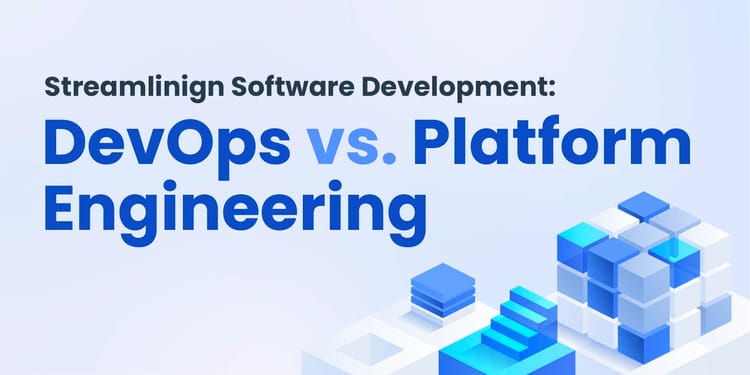DevOps opened the door to improving the overall software development process, smoothing workflows, and creating optimal pipelines for developers to ship code. From that, the field of Platform Engineering has evolved, aiming to further improve the developer experience. According to a survey from Civo, 65% of respondents agreed that platform engineering is the future.
This new field has already begun to make its mark on the tech world, with Gartner predicting that 80% of large software engineering orgs will have platform engineering teams by 2026. Not only can it improve the developer experience and efficiency, but it also helps teams deliver better code faster.
In this article, we’ll discuss platform engineering, how it differs from DevOps, the platforms it uses, and some of the tech involved. We’ll also discuss some of the common challenges that can come with adopting this new field of development.
What is Platform Engineering?
Platform engineering is a growing trend within the tech industry that focuses on creating and managing a standardized development platform to optimize the software development process. This approach is designed to help increase developer productivity, improve the quality of software, and speed up development by providing a shared foundation for development.
To create this internal platform, platform engineers built up sets of integrated tools and technologies designed to streamline development workflows, known as Internal Developer Platforms (IDPs). Instead of spending time getting their working environment up to speed, these platforms remove those extra tasks so that developers can focus more on actually writing code.
These roles emerged from the need to reduce the cognitive load on developers when creating new projects. Setting up Kubernetes clusters, building and maintaining CI/CD pipelines, and setting up security and scalability are all part of a developer’s responsibility. However, creating a dedicated role designed to focus solely on these aspects can free up other developers to focus on creating quality software.
The Difference Between DevOps and Platform Engineering
On the surface, platform engineering seems just another way to define DevOps. While they do have some crossover, they contribute differently to the overall development workflows. To learn more about the differences, check out our detailed article on platform engineering vs DevOps.
DevOps relies on a cultural shift between development and operations teams, creating a collaborative culture where they can all work together throughout the lifecycle. This means establishing and maintaining CI/CD pipelines, testing, delivery, and deployment. And with this continued monitoring, they create feedback loops to help increase performance and identify issues.
On the other hand, Platform engineers rely on creating the internal tools that developers use in their day-to-day through IDPs. They offer a standardized development and operational environment for developers to get up and running as fast as possible. At its core, it wants to abstract the complexities of the underlying systems that support both development and operations.
Both strategies aim to streamline development and deployment from different angles. DevOps seeks to shorten the development lifecycle through cultural change and automation, while Platform Engineering wants to provide a robust and standardized platform that can accelerate development.
Internal Developer Platforms (IDPs)
As we’ve mentioned before, the biggest impact that platform engineering offers is the use of IDPs. These serve as a structured development environment that aims to streamline the whole development process. Essentially, they’re a collection of tools and technologies that have been integrated and automated to focus on consistency, efficiency, and stability.
Some of the core features of IDPs are:
- Automation - IDPs heavily rely on automation to streamline workflows, from code integration to deployment. This includes automated testing, builds, and deployments, significantly reducing manual intervention and the associated risk of human error.
- Self-Service - With an IDP, developers can provision resources, access development environments, and manage deployments through a self-service portal. This enables them to perform tasks that would normally require IT or Operations.
- Standardization - IDPs help enforce best practices and consistency across the development lifecycle by centralizing tools and processes. This standardization is crucial for maintaining quality and compliance, especially in large organizations with multiple dev teams.
- Scalability and flexibility - IDPs are designed to be scalable, supporting the development needs of organizations as they grow. They also offer flexibility in integrating new tools and technologies, ensuring the development environment remains at the cutting edge.
The Tooling Landscape for Platform Engineering
The choice of tools is crucial when creating an efficient, scalable, and secure IDP. Let’s go over some of the common categories you’ll see on most platforms.
Infrastructure Automation
Terraform is a popular choice for infrastructure automation. It allows developers to define and provision infrastructure using a high-level configuration language (HashiCorp Configuration Language, or HCL for short) or JSON. Terraform’s Infrastructure as Code (IaC) model allows it to manage both cloud and on-premises resources.
Instead of creating the infrastructure, Ansible offers a configuration management tool to help configure it. While they do overlap with some features, Ansible instead focuses on configuration over orchestration. It opts to solve issues locally rather than replacing the entire system.
CI/CD
Continuous Integration/Continuous Deployment (CI/CD) tools are essential in modern software development, enabling teams to automate the testing and deployment of their code. These tools integrate with version control systems to automatically run tests whenever new code is committed, ensuring that new changes don’t break the existing application. If the tests pass, the code can be deployed across multiple environments.
Some popular tools here include Jenkins, GitlabCI/CD, and CircleCI. Each offers unique features but shares the goal of streamlining the path from code commit to deployment. These tools help reduce manual errors, increase team productivity, and speed up the release cycle, making them indispensable for IDPs.
Monitoring and Observability
Monitoring and observability tools are vital for understanding the health and performance of applications and infrastructure. Monitoring involves collecting and analyzing data to keep track of system state, while observability provides deeper insights into how the system behaves and why issues occur.
Tools like Prometheus and Grafana are widely used for monitoring, collecting metrics and providing visual dashboards, respectively. For observability, solutions like Elastic Stack (comprising Elasticsearch, Logstash, and Kibana) and Splunk offer capabilities to explore logs, metrics, and traces, helping teams diagnose and resolve issues more efficiently.
Container Orchestration
Container orchestration tools manage the lifecycle of containers in large, dynamic environments. They automate containerized applications' deployment, scaling, networking, and management.
Kubernetes is the most prominent example, providing a platform for automating the distribution and scheduling of containers across a cluster of machines. Docker Swarm offers a simpler, more integrated option for those already using Docker, focusing on ease of use and seamless integration.
These tools address the complexity of managing containers at scale, ensuring applications are run efficiently, reliably, and without downtime.
Common Challenges Within Platform Engineering
While platform engineering has plenty of advantages, it also has pitfalls. Understanding some of the common issues that may arise can make a difference once your platforms are in place or when planning to integrate them.
Complexity and Integration
Integrating so many tools into a cohesive platform can be complicated. Each tool in the stack, from CI/CD pipelines to monitoring and observability tools, comes with its own configuration and management needs. Ensuring these all work together seamlessly requires a deep understanding of all the technologies involved. This complexity can lead to issues with maintaining the platform, especially as tools are updated or replaced.
Balancing Standardization with Flexibility
One goal of platform engineering is to standardize development and operational practices across an organization. However, achieving this standardization without impeding the flexibility needed by different development teams can be difficult. Individual teams may have specific requirements that a one-size-fits-all approach cannot meet, leading to tension between the need for consistency versus team autonomy.
Skill Gaps and Training
The adoption of platform engineering practices and tools often requires skills that may not be present in existing teams. For instance, IaC, container orchestration, and advanced CI/CD pipelines may be new to developers and operations teams. Closing this skill gap requires significant training and, sometimes, hiring new talent, which can be time-consuming and costly.
Treblle's Support for Platform Engineers
Treblle offers a streamlined solution for platform engineers, focusing on API optimization and developer efficiency. Here’s how Treblle aids platform engineers:
1. API Observability and Analytics: Provides real-time insights into API performance and usage, enabling quick identification and resolution of issues to maintain optimal API functionality.
2. Developer Experience: Automates repetitive API development tasks, reducing cognitive load on developers and promoting a more efficient and creative development environment.
3. Standardization and Best Practices: Helps enforce industry best practices and consistency in API development and monitoring, ensuring high-quality output across projects.
4. Scalability and Flexibility: Offers scalable and flexible API management solutions, supporting organizational growth and the integration of new technologies without sacrificing performance.
In essence, Treblle enhances the platform engineering ecosystem by simplifying API management, improving developer productivity, and ensuring consistent application of best practices, all while accommodating growth and technological evolution.
Wrapping Up
Despite its newness, platform engineering doesn’t seem like it's going away anytime soon. The ability to deliver a smooth, consistent development experience across entire organizations can be a massive benefit to dev teams, regardless of size. Adopting this methodology can substantially boost your team’s productivity and effectiveness, but it does come with its drawbacks when first implemented. However, at the end of the day, it’s pretty easy to see how impactful platform engineering already is and how it’ll shape the future of tech.






